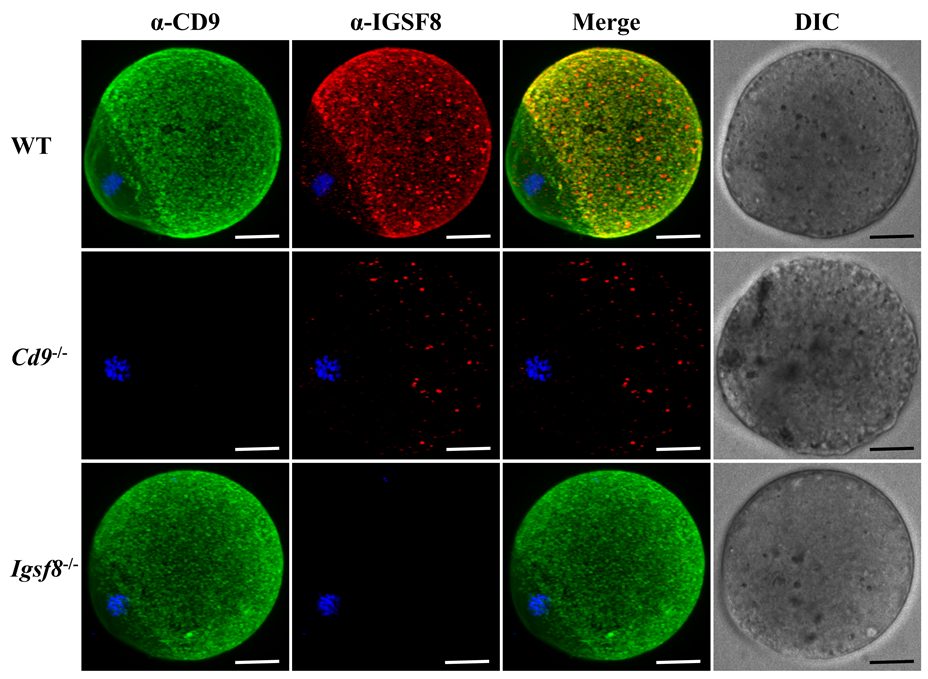|
Multiple roles of Tetraspanin-interacting protein IGSF8 B6D2;129S2-Igsf8<tm1.1Osb> (RBRC05637)Figure reproduced from ref. 5 by the courtesy of the authors and the publisher. CD9 is an essential factor in sperm-egg fusion. IGSF8 participates in the tetraspanin web and its major cis-partner is CD9. In Cd9-/- oocytes, IGSF8 was obviously reduced on the surface compared with the wild-type (top and middle). However, Igsf8-/- oocytes had normal CD9 protein levels and distribution (bottom). In fact, the Igsf8-/- female mice showed no fertilization defects in vitro or in vivo. Thus, Inoue and colleagues have concluded that IGSF8 is dispensable for fertility. Scale bar = 20 µm. |
| An immunoglobulin superfamily member IGSF8 (also known as EWI-2) has four extracellular Ig-like domains including a transmembrane domain that directs its interaction with tetraspanins CD9 and CD81. Microvesicles containing tetraspanins play an essential role in many physiological processes, indicating the involvement of IGSF8 in cell adhesion, migration, and differentiation. IGSF8 is present in developing olfactory sensory neuron synapses and interacts with CD9 [1]. IGSF8 is one of the transmembrane proteins for selecting progenitors for midbrain dopamine neurons, which can be a tool for cell replacement therapy for Parkinson’s disease [2]. IGSF8−α-actinin complex is involved in the regulation of the actin cytoskeleton at T cell immune and virological synapse area [3]. Recent studies revealed that homozygous deletion of IGSF8 was found almost exclusively in human prostate cancer cells but not in other cancer types [4]. On the other hand, Igsf8-deficient eggs have normal CD9 protein level and distribution on their surface [5]. IGSF8 is dispensable for fertility of mouse eggs, although Cd9– and/or Cd81-deficient eggs fail to fertilize. Igsf8 conditional knockout strain is a useful resource to clarify cell type-specific roles of IGSF8. |
| Depositor | : | Naokazu Inoue, Ph.D. Department of Cell Science Institute of Biomedical Sciences, Fukushima Medical University |
|
| Strain name | : | B6D2;129S2-Igsf8<tm1.1Osb> | |
| RBRC No. | : | RBRC05637 | |
| References | : | [1] | Ray A, Treloar HB. IgSF8: a developmentally and functionally regulated cell adhesion molecule in olfactory sensory neuron axons and synapses. Mol Cell Neurosci.; 50(3-4):238-49, 2012. |
| [2] | Bye CR, Jönsson ME, Björklund A, Parish CL, Thompson LH. Transcriptome analysis reveals transmembrane targets on transplantable midbrain dopamine progenitors. Proc Natl Acad Sci U S A.; 112(15):E1946-55, 2015. | ||
| [3] | Gordón-Alonso M, Sala-Valdés M, Rocha-Perugini V, Pérez-Hernández D, López-Martín S, Ursa A, Alvarez S, Kolesnikova TV, Vázquez J, Sánchez-Madrid F, Yáñez-Mó M. EWI-2 association with α-actinin regulates T cell immune synapses and HIV viral infection. J Immunol.; 189(2):689-700, 2012. | ||
| [4] | Levina E, Ji H, Chen M, Baig M, Oliver D, Ohouo P, Lim CU, Schools G, Carmack S, Ding Y, Broude EV, Roninson IB, Buttyan R, Shtutman M. Identification of novel genes that regulate androgen receptor signaling and growth of androgen-deprived prostate cancer cells. Oncotarget; 6(15):13088-104, 2015. | ||
| [5] | Inoue N, Nishikawa T, Ikawa M, Okabe M. Tetraspanin-interacting protein IGSF8 is dispensable for mouse fertility. Fertil Steril.; 98(2):465-70, 2012. | ||
| August 2015 Contact: Shinya Ayabe, Ph.D. Experimental Animal Division, RIKEN BioResource Center All materials contained on this site may not be reproduced, distributed, displayed, published or broadcast without the prior permission of the owner of that content. |






